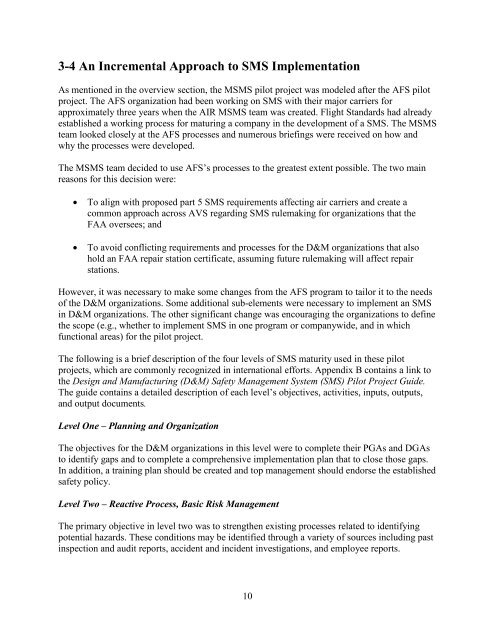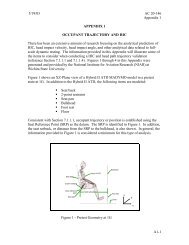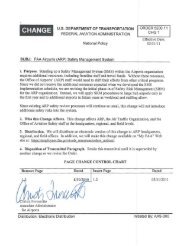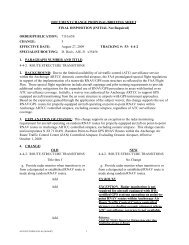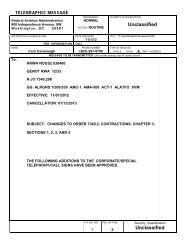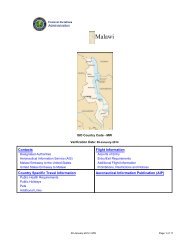2009 SMS Pilot Project (SMSPP) Analysis - FAA
2009 SMS Pilot Project (SMSPP) Analysis - FAA
2009 SMS Pilot Project (SMSPP) Analysis - FAA
You also want an ePaper? Increase the reach of your titles
YUMPU automatically turns print PDFs into web optimized ePapers that Google loves.
3-4 An Incremental Approach to <strong>SMS</strong> Implementation<br />
As mentioned in the overview section, the M<strong>SMS</strong> pilot project was modeled after the AFS pilot<br />
project. The AFS organization had been working on <strong>SMS</strong> with their major carriers for<br />
approximately three years when the AIR M<strong>SMS</strong> team was created. Flight Standards had already<br />
established a working process for maturing a company in the development of a <strong>SMS</strong>. The M<strong>SMS</strong><br />
team looked closely at the AFS processes and numerous briefings were received on how and<br />
why the processes were developed.<br />
The M<strong>SMS</strong> team decided to use AFS’s processes to the greatest extent possible. The two main<br />
reasons for this decision were:<br />
• To align with proposed part 5 <strong>SMS</strong> requirements affecting air carriers and create a<br />
common approach across AVS regarding <strong>SMS</strong> rulemaking for organizations that the<br />
<strong>FAA</strong> oversees; and<br />
• To avoid conflicting requirements and processes for the D&M organizations that also<br />
hold an <strong>FAA</strong> repair station certificate, assuming future rulemaking will affect repair<br />
stations.<br />
However, it was necessary to make some changes from the AFS program to tailor it to the needs<br />
of the D&M organizations. Some additional sub-elements were necessary to implement an <strong>SMS</strong><br />
in D&M organizations. The other significant change was encouraging the organizations to define<br />
the scope (e.g., whether to implement <strong>SMS</strong> in one program or companywide, and in which<br />
functional areas) for the pilot project.<br />
The following is a brief description of the four levels of <strong>SMS</strong> maturity used in these pilot<br />
projects, which are commonly recognized in international efforts. Appendix B contains a link to<br />
the Design and Manufacturing (D&M) Safety Management System (<strong>SMS</strong>) <strong>Pilot</strong> <strong>Project</strong> Guide.<br />
The guide contains a detailed description of each level’s objectives, activities, inputs, outputs,<br />
and output documents.<br />
Level One – Planning and Organization<br />
The objectives for the D&M organizations in this level were to complete their PGAs and DGAs<br />
to identify gaps and to complete a comprehensive implementation plan that to close those gaps.<br />
In addition, a training plan should be created and top management should endorse the established<br />
safety policy.<br />
Level Two – Reactive Process, Basic Risk Management<br />
The primary objective in level two was to strengthen existing processes related to identifying<br />
potential hazards. These conditions may be identified through a variety of sources including past<br />
inspection and audit reports, accident and incident investigations, and employee reports.<br />
10


